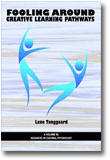
Fooling Around
Creative Learning Pathways
Edited by:
Lene Tanggaard, Aalborg University
A volume in the series: Advances in Cultural Psychology: Constructing Human Development. Editor(s): Jaan Valsiner, Niels Bohr Professor of Cultural Psychology, Aalborg University.
Published 2014
Some old ideas can become very new. This is the case of the notion of creativity in psychology. Traditionally conceptualized in the narrow framework of the amazing things poets, composers, painters, and scientists do, creativity research had reached an impassé in its efforts to locate creativity within the confines of personality characteristics.
This is the time for change. The New Look at creativity that is rooted within the sociocultural tradition in psychology and elaborated in the present book finds creativity in each and every moment of our everyday lives. We are creative when we move around in the streets, dance tango, fool around with our self-images while shopping for clothes, or resist pre-given recipes while cooking dinners. We are being creative even in our bedrooms where we perform the difficult tasks of falling asleep or waking up through arrays of sleep inducers and alarm clocks, not to speak of the time we spend in the very state of sleep. All our actions at night—ranging from what we later call nightmares--or dreams—are arenas of creativity even if we may barely remember what we have done.
The present monograph by Lene Tanggaard constitutes a powerful multi-pronged exposition of the New Look at Creativity. Its starting point is in the move to pay attention to the processes of acting in everyday life—rather than start from the classification of products of human actions into classes of “creative” versus “non-creative.”
CONTENTS
Series Editor’s Preface: Handling the Creative Process: The Importance of Fooling Around, Jaan Valsiner. Foreword. 1. Everyday Life Studies of Creativity. 2. Creative Learning—Not just for the Celebrated Few. 3. Immersion, Fooling Around, and Resistance: Three Creative Learning Pathways. 4. A Short Story of Creativity Theories. SECTION 1: EMPIRICAL STUDIES OF CREATIVITY 5. Stories About Creative Teaching and Productive Learning: Daring to Be a Little Bold. 6. Herlufsholm and Reclaiming Creativity. 7. On the Shoulders of Francis Bacon. 8. Two Types of Creative Apprenticeships. SECTION 2: A PRACTICE-DEVELOPING CREATIVITY MODEL 9. A Model for Developing Creativity through Creative Learning Pathways. 10. The Inevitability of Creativity in Modern Society. 11. Creativity in Children’s Lives: An Unconditional Good For Whom? 12. Conclusion and Perspectives. 13. Concluding Remarks on the Methodology Driving the Empirical Parts of the Book. References.
-
Paperback9781623965921
Web price: $45.04 (Reg. 52.99)
-
Hardcover9781623965938
Price: $57.49
- eBook9781623965945

- PSY030000 - PSYCHOLOGY: Research & Methodology
- PSY031000 - PSYCHOLOGY: Social Psychology
- PSY034000 - PSYCHOLOGY: Creative Ability
-
 Culture, Work and Psychology
Invitations to Dialogue
Culture, Work and Psychology
Invitations to Dialogue
-
 Deep Loyalties
Values in Military Lives
Deep Loyalties
Values in Military Lives
-
 Drama of Multilingualism
Literature Review and Liberation
Drama of Multilingualism
Literature Review and Liberation
-
 From Dream to Action
Imagination and (Im)Possible Futures
From Dream to Action
Imagination and (Im)Possible Futures
-
 Home in Transition
The Cultural Construction of Heimat
Home in Transition
The Cultural Construction of Heimat
-
 Making of Distinctions
Towards a Social Science of Inclusive Oppositions
Making of Distinctions
Towards a Social Science of Inclusive Oppositions
-
 Ornamented Lives
Ornamented Lives

